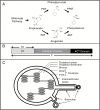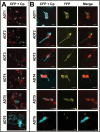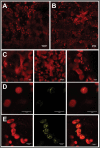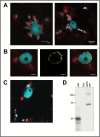Subcellular localization of Arabidopsis arogenate dehydratases suggests novel and non-enzymatic roles
- PMID: 28338876
- PMCID: PMC5444438
- DOI: 10.1093/jxb/erx024
Subcellular localization of Arabidopsis arogenate dehydratases suggests novel and non-enzymatic roles
Abstract
Arogenate dehydratases (ADTs) catalyze the final step in phenylalanine biosynthesis in plants. The Arabidopsis thaliana genome encodes a family of six ADTs capable of decarboxylating/dehydrating arogenate into phenylalanine. Using cyan fluorescent protein (CFP)-tagged proteins, the subcellular localization patterns of all six A. thaliana ADTs were investigated in intact Nicotiana benthamiana and A. thaliana leaf cells. We show that A. thaliana ADTs localize to stroma and stromules (stroma-filled tubules) of chloroplasts. This localization pattern is consistent with the enzymatic function of ADTs as many enzymes required for amino acid biosynthesis are primarily localized to chloroplasts, and stromules are thought to increase metabolite transport from chloroplasts to other cellular compartments. Furthermore, we provide evidence that ADTs have additional, non-enzymatic roles. ADT2 localizes in a ring around the equatorial plane of chloroplasts or to a chloroplast pole, which suggests that ADT2 is a component of the chloroplast division machinery. In addition to chloroplasts, ADT5 was also found in nuclei, again suggesting a non-enzymatic role for ADT5. We also show evidence that ADT5 is transported to the nucleus via stromules. We propose that ADT2 and ADT5 are moonlighting proteins that play an enzymatic role in phenylalanine biosynthesis and a second role in chloroplast division or transcriptional regulation, respectively.
Keywords: Arogenate dehydratase; chloroplast division; moonlighting proteins; nuclear localization; phenylalanine biosynthesis; stromules..
© The Author 2017. Published by Oxford University Press on behalf of the Society for Experimental Biology.
Figures








Similar articles
-
Moonlighting proteins: putting the spotlight on enzymes.Plant Signal Behav. 2018;13(10):e1517075. doi: 10.1080/15592324.2018.1517075. Epub 2018 Sep 25. Plant Signal Behav. 2018. PMID: 30252596 Free PMC article.
-
Phenylalanine biosynthesis in Arabidopsis thaliana. Identification and characterization of arogenate dehydratases.J Biol Chem. 2007 Oct 19;282(42):30827-35. doi: 10.1074/jbc.M702662200. Epub 2007 Aug 28. J Biol Chem. 2007. PMID: 17726025
-
Arogenate Dehydratase Isoforms Differentially Regulate Anthocyanin Biosynthesis in Arabidopsis thaliana.Mol Plant. 2016 Dec 5;9(12):1609-1619. doi: 10.1016/j.molp.2016.09.010. Epub 2016 Oct 5. Mol Plant. 2016. PMID: 27720844
-
Complementation of the pha2 yeast mutant suggests functional differences for arogenate dehydratases from Arabidopsis thaliana.Plant Physiol Biochem. 2011 Aug;49(8):882-90. doi: 10.1016/j.plaphy.2011.02.010. Epub 2011 Feb 17. Plant Physiol Biochem. 2011. PMID: 21388819
-
Phenylalanine roles in the seed-to-seedling stage: Not just an amino acid.Plant Sci. 2019 Dec;289:110223. doi: 10.1016/j.plantsci.2019.110223. Epub 2019 Aug 20. Plant Sci. 2019. PMID: 31623788 Review.
Cited by
-
Arogenate dehydratases: unique roles in light-directed development during the seed-to-seedling transition in Arabidopsis thaliana.Front Plant Sci. 2023 Aug 2;14:1220732. doi: 10.3389/fpls.2023.1220732. eCollection 2023. Front Plant Sci. 2023. PMID: 37600200 Free PMC article.
-
Plastidial NAD-Dependent Malate Dehydrogenase: A Moonlighting Protein Involved in Early Chloroplast Development through Its Interaction with an FtsH12-FtsHi Protease Complex.Plant Cell. 2018 Aug;30(8):1745-1769. doi: 10.1105/tpc.18.00121. Epub 2018 Jun 22. Plant Cell. 2018. PMID: 29934433 Free PMC article.
-
Maize big embryo 6 reveals roles of plastidial and cytosolic prephenate aminotransferases in seed and plant development.Plant Cell. 2025 Jun 4;37(6):koaf067. doi: 10.1093/plcell/koaf067. Plant Cell. 2025. PMID: 40476681 Free PMC article.
-
Redirecting Primary Metabolism to Boost Production of Tyrosine-Derived Specialised Metabolites in Planta.Sci Rep. 2018 Nov 22;8(1):17256. doi: 10.1038/s41598-018-33742-y. Sci Rep. 2018. PMID: 30467357 Free PMC article.
-
Plastid Envelope-Localized Proteins Exhibit a Stochastic Spatiotemporal Relationship to Stromules.Front Plant Sci. 2018 Jun 4;9:754. doi: 10.3389/fpls.2018.00754. eCollection 2018. Front Plant Sci. 2018. PMID: 29915611 Free PMC article.
References
-
- Agati G, Biricolti S, Guidi L, Ferrini F, Fini A, Tattini M. 2011. The biosynthesis of flavonoids is enhanced similarly by UV radiation and root zone salinity in L. vulgare leaves. Journal of Plant Physiology 168, 204–212. - PubMed
-
- Bross CD, Corea ORA, Kaldis A, Menassa R, Bernards MA, Kohalmi SE. 2011. Complementation of the pha2 yeast mutant suggests functional differences for arogenate dehydratases from Arabidopsis thaliana. Plant Physiology and Biochemistry 49, 882–890. - PubMed
-
- Cho MH, Corea ORA, Yang H, et al. 2007. Phenylalanine biosynthesis in Arabidopsis thaliana. Identification and characterization of arogenate dehydratases. Journal of Biological Chemistry 282, 30827–30835. - PubMed
Publication types
MeSH terms
Substances
LinkOut - more resources
Full Text Sources
Other Literature Sources
Molecular Biology Databases
Miscellaneous

